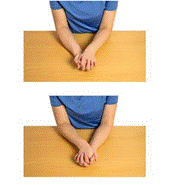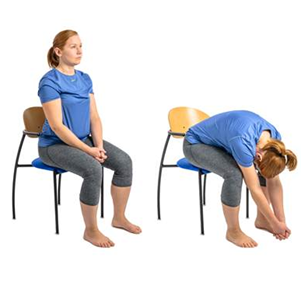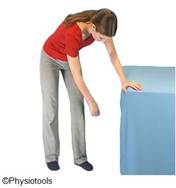This leaflet has been produced to give you general information about your injury. Most of your questions should be answered by this leaflet. It is not intended to replace the discussion between you and the healthcare team but may act as a starting point for discussion. If after reading it you have any concerns or require further explanation, please discuss this with a member of the healthcare team.
What is a shoulder soft tissue injury?
The term soft tissue refers to muscles, ligaments and tendons that surround and support our joints. Injuries to the soft tissue around the shoulder can occur due to falling on an outstretched hand, overuse, or direct impact.
What are the symptoms?
Symptoms vary but may include;
- Pain in the shoulder and upper arm – this pain may radiate down the arm in more severe cases and may present as an ache or sharp pain
- Pain during overhead activities, lifting, driving, or reaching
- Pain when sleeping or lying on the shoulder
- Pain that affects your sleep or may be worse at night
- Mild weakness of the shoulder muscles making it hard for you to lift your arm.
How long will it take to recover?
- Healing from soft tissue injuries normally takes about six weeks, but can continue for three months, as everyone recovers from injuries at different rates.
- Returning to higher activity levels and sport may take longer. These time frames may be dependent on following early advice and rehabilitation.
Caring for your injury in the first 48 hours
- It is important to rest your shoulder in the early stages from further stresses. This will allow the healing process to take place effectively.
- Depending on the severity of your injury, you may be provided with a sling for your arm to make you more comfortable. The professional assessing you will decide whether this is necessary.
- Please take regular breaks from using the sling, and whilst you are taking a break from the sling it is important to keep your arm and neck moving. Your sling can be worn for comfort. You can take it off to wash, dress and do your exercises. It does not need to be worn at night. You shoulder stop using your sling as soon as possible.
- Elevation – try to elevate your shoulder by placing pillows under your shoulder and elbow to help with swelling.
Caring for your injury: week 1-2
Using a cold pack will help with your pain. There is some evidence that early use of ice may impair healing. Therefore after 72 hours-the initial acute phase, you can use an ice pack or bag of frozen peas wrapped in a damp towel. Put this on your shoulder for up to 15 minutes every few hours. Make sure the ice is not in direct contact with your skin. You may also find heat helpful, a hot water bottle with warm water (not boiling) or a heat pack on your shoulder.
Sling use. You should wean and stop the use of the sling after 72 hours; this is so your shoulder can move without restriction and avoid shoulder stiffness. If you have been advised to wear this for longer by a healthcare professional, then continue to do so for the specified time.
Exercises. Early gentle movement of the shoulder is importance to prevent stiffness and promote circulation and movement.
Driving / Work / Sport
- Returning to driving and work will depend on your individual injury, and what your occupation is
- We recommend before returning to driving that you can perform an emergency stop and fully control the steering wheel without hesitation and discomfort, and inform your insurance company.
- As you return to work, you may find that your arm becomes more fatigued as the day goes on. You may wish to rest it temporarily in the sling in the evening to reduce discomfort. This change may be more significant if you do a manual job.
- Return to sport is usually dependent on symptoms and the individual’s injury. You should be able to use the limb normally with no pain but a return to racket and contact sports may take a little longer. Return to sport should be with graded return; for example, returning to light activity / training before taking part in a match. If you have any concerns regarding your recovery, please see your GP.
Exercise and activity:
It is important to start gentle exercises straight away to prevent stiffness. You can return to activity when you feel read. Start light tasks and be guided by your plan. Please follow the below exercises.
Early exercises (first 0 – 2 weeks)
Elbow movement
Bend and straighten your elbow, using the other hand to help if needed.

Elbow movement
Support your forearm and turn your palms up to face the ceiling and turn them down to face the floor as pain allows.
This movement should occur at your elbow and not your shoulder.

Hand, wrist & finger movement
Move the wrist up and down.
Make a full fist and stretch your fingers out wide.

Later exercises: from 2 – 3 weeks
Again, all exercises must be performed within the limits of tolerable pain. Please do these exercises regularly at home, attempting at least 5 – 10 repetitions, 3 times per day. Do not force or stretch. Continue to take regular painkillers.
Seated exercise
Sitting down.
Support your painful side with your opposite hand. Slide your hands down your thigh as far as is comfortable, return to the start position.

Pendulum exercise
Resting your non-injured arm on a table, bend at the waist & let your painful arm hang forward.
Make a circular or forwards and backwards motion with your whole arm.
Don’t do this if you have poor balance.

Table walk aways
Rest your hands on the edge of sink or work top. Walk back until you feel discomfort. Nice and gently to start with.
You can wash under your armpit whilst the arm is supported.

Tabletop slides
Sit or stand. Place your hands on a table on a towel or kitchen roll.
Start with the hand of your painful arm on top of your other hand to help it. Slide your hands along the table, reaching forwards and straighten your elbows as much as possible. Slide your hands back. Do small movements to start with.

External rotation with a stick
Sit or lie down with both elbows bent at right angles.
Place a rolled towel between your elbow and side if sitting down. Hold a stick with both hands.
Gently push the stick to move the hand outwards, keeping your elbow in at your side.

Active assisted flexion
Sitting down. Support your painful arm with the opposite hand.
Gently lift the arm as far as it will move comfortably. Do not force.

When you feel comfortable with the above exercises, you may be able to progress on to the following but only do within limits of tolerable pain.

Assisted shoulder flexion
Lying on your back, elbow bent. Clasp your hands or hold at your painful arm’s wrist. Straighten your arms towards the ceiling.
If you can, you can take the arm overhead but only if it is comfortable.

Hand behind back
Stand tall. Relax your shoulders. Place one hand behind your back and gently slide it along your back to the midline. Gently release to the starting position. Help with your other hand if you can.
Nice and gently to start with. Let pain be your guide with this.